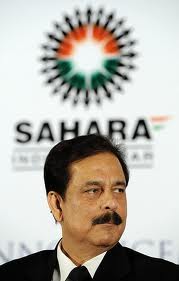2.6 m Shareholders, but Sahara Co Still Unlisted
Sahara India Commercial Not on Bourses Despite 3,000-cr Issue
In October 2009, Sahara India Commercial Corporation (SICCL), part of Sahara Group of Companies, decided to issue shares to a bunch of investors. While the size of the share issue— 3,000 crore—was substantial, what was really startling was not the amount, but the number of shareholders who were allotted shares: 2.6 million. Even if this were the only share issue by the company, it would make it the third-largest company in the country today in terms of number of shareholders—behind Reliance Power (4.9 million shareholders as of December 2010), and Reliance Industries (3.5 million). That share issue by SICCL placed it far ahead of other stellar names of India Inc such as Tata Steel and NTPC, in terms of the shareholder base.
But here’s the real surprise. Despite the share issue, SICCL is not listed on any stock exchange. According to filings by the company with the registrar of companies, West Bengal, the company issued 30 crore shares with a face value of 1, at a premium of 99, on October 29, 2009. The number of allottees were 26,89,935. The company has also uploaded, on the RoC site, a long list of the share allottees. The shares have not been listed on any exchange. “The companies act and SEBI regulations are clear,” says Tejesh Chitlangi, a senior associate with Finsec Law Advisors: “Section 67 of The Companies Act construes an offering of shares or debentures to 50 or more persons as an offer or invitation to the public, for which norms listed out in SEBI Regulations would need to be followed. These include issuing of prospectus, compliance with the procedures and other disclosure norms.”
In response to a questionnaire sent by ET, Sahara spokesperson, Abhijit Sarkar said: “SICCL is an unlisted public limited company and does not intend to list its shares at any of the stock exchanges as decided by the board of directors of the company. Compliances with the SEBI Regulations are applicable for the listed companies as well the company who intend to get their shares listed on the stock exchanges.”
He said necessary board and shareholder approvals were taken. Further, the fact that the return of allotment was duly approved by RoC West Bengal was evidence that “required compliances for allotment of equity shares by the company are fully complied with”. According to Sahara, an approval from the RoC was given in September 2010.
Staying Away from the Street Sahara arm not listed on any stock exchange
The company: Sahara India Commercial Corporation
Business: Real Estate and infrastructure
No. of shareholders: 2.6 million Funds raised: Rs 3,000 crore
Type of company: Public, but unlisted
•Third-largest company in India today in terms of number of shareholders—behind Reliance Power and Reliance Industries
• As of March 2009, SICCL posted a loss before tax of Rs 449 cr, on revenues of Rs 1,600 cr
• Its balance-sheet size, as of March 2009, was Rs 8,591 cr. Over 80% of this, Rs 6,922 cr, was raised through OFCDs Two Share Allotments
Says Jayant Thakur, a chartered accountant specialising in securities law: “When a company raises funds from more than 50 people, it does not remain a private placement, but is a public issue. For this, listing requirements, as well as other SEBI norms must be followed.” SICCL, according to other filings with the RoC, is primarily a real estate and infrastructure developer. Documents filed by the company describe it as ‘perhaps one of the largest infrastructure and housing development company in India.” As of March 2009, the company posted a loss before tax of . 449 crore, on revenues of . 1,600 crore. SICCL’s balance-sheet size, as of March 2009, was . 8,591 crore. Of this, . 6,922 crore (over 80%) was raised through the issue of optionally fully convertible debentures, or OFCDs. OFCDs are bonds, which on maturity, and at the option of the investor, can be converted into equity shares.
Between March 2009 and June 2010, SICCL completed two share allotments—one for . 3,000 crore to 2.6 million investors, and the other of . 2,000 crore, done on June 30, 2010, to five private limited companies. Thus the total amount of shares issued by the company, as a result of these two allotments, was . 5,000 crore. It could not be ascertained whether the two share allotments arose as a result of the conversion of OFCDs, issued earlier by the company, into shares or whether these were standalone issues of shares to investors. Sahara Group did not give details about the circumstances under which the shares were issued.
According to SICCL’s debenture prospectus, shareholder approvals for OFCDs were given at seven different meetings held between 1998 and 2005 and were to be on private placement basis to “friends, associates, group companies, workers/employees and individuals having their association with group companies”. The OFCD issue opened on July 6, 1998, and closed on June 30, 2008. According to the debenture prospectus, the total size of the issue, spread over five types of bonds, and 10 years, was . 17,250 crore. The funds raised were to be used to finance a number of projects, including the development of the Aamby Valley project.
Late last year, the Securities and Exchange Board of India (SEBI) had banned two other Sahara Group companies—Sahara India real estate corporation (SIRECL), and Sahara Housing Investment Corporation(SHICL)—from raising funds from the public through the issue of OFCDs, without going through the necessary approvals and procedures required. The two companies claimed that they had not made a ‘public offer’ (defined as an offer to more than 50 investors), as claimed by SEBI, but had placed the debentures privately and among a few friends, associates and others close to the group. Therefore, the companies claimed, SEBI had no jurisdiction. The market regulator, disagreeing with the claim of a ‘private placement’, had imposed the ban.
The SEBI ban on the other two Sahara companies was stayed by the Allahabad High Court but the stay order was lifted earlier this month. SEBI has filed a caveat in the Supreme Court against the issuance of any ex-parte orders in the case (which are issued without one of the parties being present). Sahara is reported to have filed a special leave petition in the Supreme Court as well, though this could not be confirmed.
Always Yours — As Usual — Saurabh Singh









Impressions of Visitor & Few Replies